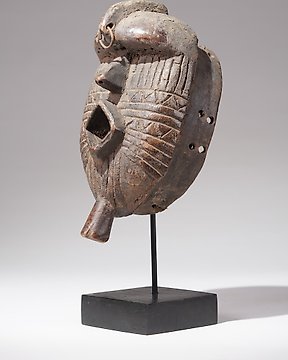
Nunuma - Burkina Faso (Bez ceny minimalnej )
Nr 83440919

Nr 83440919

A high abstract Kurumba headdress, Burkina Faso, collected in the region Arbida, the village is unknown, uprising from a cylindrical, uprising from a cone-shaped base, which showes pigments with weathered triangular patterns, extends a highly abstract openwork panel made of numerous coloured rods, which rise laterally through an extension of the base, one particularly outstanding rod gives the impression that it is could be an abstracted antelope head, which would correspond to the well known known type of the Korumba dance masks, provenance Belo Mohamed Gatba.
The Kurumba people produce mainly a mask headdress in the form of an antelope. But also this extremly rare type belongs to this ethnic group. The powerful neck supports a head with a long pointed protruding snout. Earlier versions had large ears curving to the towering horns in a semi-circular fashion (echoing the curve of the chi wara mane of the Bamana). These earlier versions (except for heads 6 and 7) were fashioned with masks covering the face much like the masks of neighboring Dogon cultures.
The new styles are secured to the top of the head with head and shoulders disguised with raffia. The dancer wears a raffia skirt. Like the Bamana, they dance in pairs and sometimes appear with a masked hyena dancer.
Kurumba masks are used in three major events during the annual cycle: masks escort the corpse of dead male and female elders to the tomb and supervise the burial on behalf of the spirits of the ancestors of the clan. Weeks or even months later, during the dry season, masks appear at funerals to honor the deceased and to free the spirit to travel to the world of ancestors. Finally, just before the first rains in late May and June, masks appear at collective sacrifices in which the ancestors are honored together with the spirits of the protective antelope, that is the totem of most Kurumba clans.
These functions conform to patterns throughout Burkina Faso, especially in the north. Masks appear for the same events among the northern Mossi, in Yatenga, Risiam, and Kaya, because the ancestors of the northeastern Mossi who use masks were Kurumba. At funerals, and at public performances following the funeral, masks are physical reembodiments of the spirit of the deceased elder, and the mask may be addressed using the dead person's name. The mask is a means of preserving the memory of the dead, by providing a physical reminder of the dead elder's achievements in life. As among the Mossi, masks are used as portable altars on which the living may offer sacrifices to the dead, securing their blessings for the year to come. In addition, the mask carved at the death of a high-ranking clan elder serves to enhance the prestige of the deceased. When not in use, masks may be placed on altars in the ancestral spirit house within the family compound.
Among the Kurumba as among peoples in central Burkina Faso, the geometric patterns painted on masks are symbols that refer to major events in the myths of the founding of the clan, and the masks themselves represent the antelope that played a role in these stories when it saved the life of the founding elder.
Sources: A History of Art in Africa / Africa - The Art of a Continent / The Tribal Art of Africa / The Dance, Art and Ritual of Africa.
Jak kupować w serwisie Catawiki
1. Odkryj coś wyjątkowego
2. Złóż najwyższą ofertę
3. Dokonaj bezpiecznej płatności